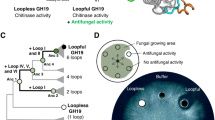Abstract
We expressed a truncated version of the Clostridium thermocellum xylanase (xynZ) gene in transgenic tobacco plants. High levels of the 37 kD protein were synthesized and correctly targeted to the intercellular space by means of the proteinase inhibitor II signal peptide. The protein was one of the most abundant proteins in total extracts that were not protected against proteolysis. Enzyme extracted from leaves retained its activity and hydrolyzed xylan efficiently to xylo-oligomers and xylose. Enzymatic activity could be enriched about 14 to 31-fold after heat-treatment with essentially complete recovery. The transgenic plants, grown under greenhouse conditions, were not affected by the foreign enzyme, possibly due to the high temperature optimum (70°C) of the xylanase and low levels of xylan in dicotyledons. These plants might be useful for production of the enzyme which has numerous applications hi the paper industry and agriculture.
This is a preview of subscription content, access via your institution
Access options
Subscribe to this journal
Receive 12 print issues and online access
$209.00 per year
only $17.42 per issue
Buy this article
- Purchase on Springer Link
- Instant access to full article PDF
Prices may be subject to local taxes which are calculated during checkout
Similar content being viewed by others
References
Timell, T.E. 1967. Recent progress in the chemistry of wood hemicelluloses. Wood Sci. Technol. 1: 45–70.
McNeil, M., Darvill, A.G., Fry, S.C. and Albersheim, P. 1984. Structure and function of the primary cell walls of plants. Annu. Rev. Biochem. 53: 625–663.
Biely, P. 1985. Microbial xylanolytic systems. Trends in Biotechnology 3: 286–290.
Wong, K.K.Y., Tan, L.U.L. and Saddler, J.N. 1988. Multiplicity of β-1,4-xylanase in microorganisms: Functions and applications. Microbiol. Reviews 52: 305–317.
Grépinet, O., Chebrou, M.-C. and Béguin, P. 1988. Purification of Clostridium themocellum Xylanase Z expressed in Escherichia coli and identification of the corresponding product in the culture medium of C. thermocettum . J. Bacteriol. 170: 4576 4581.
Grépinet, O., Chebrou, M.-C. and Bégum, P. 1988. Nucleotide sequence and deletion analysis of the xylanase gene (xynZ) of Clostridium thermocellum . J. Bacteriol. 170: 4582 4588.
Höfgen, R. and Willmitzer, L. 1990. Biochemical and genetic analysis of different patatin isoforms expressed in various organs of potato (Solomon tuberosum L.). Plant Sci. 66: 221–230.
von Schaewen, A., Stitt, M., Schmidt, R., Sonnewald. U. and Willmitzer, L. 1990. Expression of a yeast-derived invertase in the cell wall of tobacco and Arabidopsis plants leads to accumulation of carbohydrate and inhibition of photosynthesis and strongly influences growth and phenotype of transgenic tobacco plants. EMBO J. 9: 3033–3044.
Thomas, J.R., McNeil, M., Darvill, A.G. and Albersheim, P. 1987. Structure of plant cell walls. XIX. Isolation and characterization of wall polysaccharides from suspension-cultured douglas fir cells. Plant Physiol 83: 659–671.
Rosahl, S., Schmidt, R., Schell, J. and Willmitzer, L. 1987. Expression of a tuber-specific storage protein in transgenic tobacco plants: demonstration of an esterase activity. EMBO J. 6: 1155–1159.
Bradford, M.M. 1976. Rapid and quantitative method for quantification of microgram quantities of protein utilizing the principle of protein-dye binding. Anal. Biochem. 72: 248–252.
Dubois, M., Gilles, K.A., Hamilton, J.K., Rebers, P.A. and Smith, F. 1956. Colorimetric method for determination of sugars and related substances. Anal. Chem. 28: 350–356.
Laliberté, J.-E., Nicolas, O., Durand, S. and Morosoli, R. 1992. The xylanase introns from Cryptococcus albidus are accurately spliced in transgenic tobacco plants. Plant Mol. Biol. 18: 447–451.
Sambrook, J., Fritsch, E.F. and Maniatis, T. 1989. Molecular Cloning: A Laboratory Manual. Cold Spring Harbor Laboratory Press, Cold Spring Har bor, New York
Deblaere, R., Bytebier, B., de Greve, H., Debroeck, F.M., Schell, J., van Montagu, M. and Leemanns, J. 1985. Efficient octopine Ti-plasmid derived vectors for Agrobacterium-mediated gene transfer. Nucleic Acids Res. 13: 4777–4788.
Royer, J.C. and Nakas, J.P. 1990. Simple, sensitive zymogram technique for detection of xylanase activity in polyacrylamide gels. App. Environ. Microbiol. 56: 1516–1517.
Logemann, J., Schell, J. and Willmitzer, L. 1987. Improved method for the isolation of RNA from plant tissues. Anal. Biochem. 163: 21–26.
Amasino, R.M. 1986. Acceleration of nucleic acid hybridisation rate by poly ethylene glycol. Anal. Biochem. 152: 304–307.
Laemmli, U.K. 1970. Cleavage of structural proteins during assembly of the head of bacteriophage T4. Nature 227: 680–685.
Biely, P., Mislovicova, D. and Toman, R. 1988. Remazol Brilliant Blue-Xylan: A soluble chromogenic substrate for xylananases. Methods Enzymol. 160: 536–542.
Chaplin, M.F. 1986. Monosaccharides, p. 3. In: Carbohydrate Analysis a Practical Approach. Chaplin, M.F. and Kennedy, J.F. (Eds.). IRL Press, Oxford.
Author information
Authors and Affiliations
Rights and permissions
About this article
Cite this article
Herbers, K., Wilke, I. & Sonnewald, U. A Thermostable Xylanase from Clostridium thermocellum Expressed at High Levels in the Apoplast of Transgenic Tobacco Has No Detrimental Effects and Is Easily Purified. Nat Biotechnol 13, 63–66 (1995). https://doi.org/10.1038/nbt0195-63
Received:
Accepted:
Issue Date:
DOI: https://doi.org/10.1038/nbt0195-63
This article is cited by
-
Xylan-breakdown apparatus of Clostridium thermocellum
Cellulose (2022)
-
Leaf infiltration in plant science: old method, new possibilities
Plant Methods (2021)
-
Production of recombinant human deoxyribonuclease I in Luffa cylindrica L. and Nicotiana tabacum L.: evidence for protein secretion to the leaf intercellular space
Plant Cell, Tissue and Organ Culture (PCTOC) (2019)
-
Seed specific expression and analysis of recombinant human adenosine deaminase (hADA) in three host plant species
Transgenic Research (2016)
-
Cell wall modification in tobacco by differential targeting of recombinant endoglucanase from Trichoderma reesei
BMC Plant Biology (2015)



